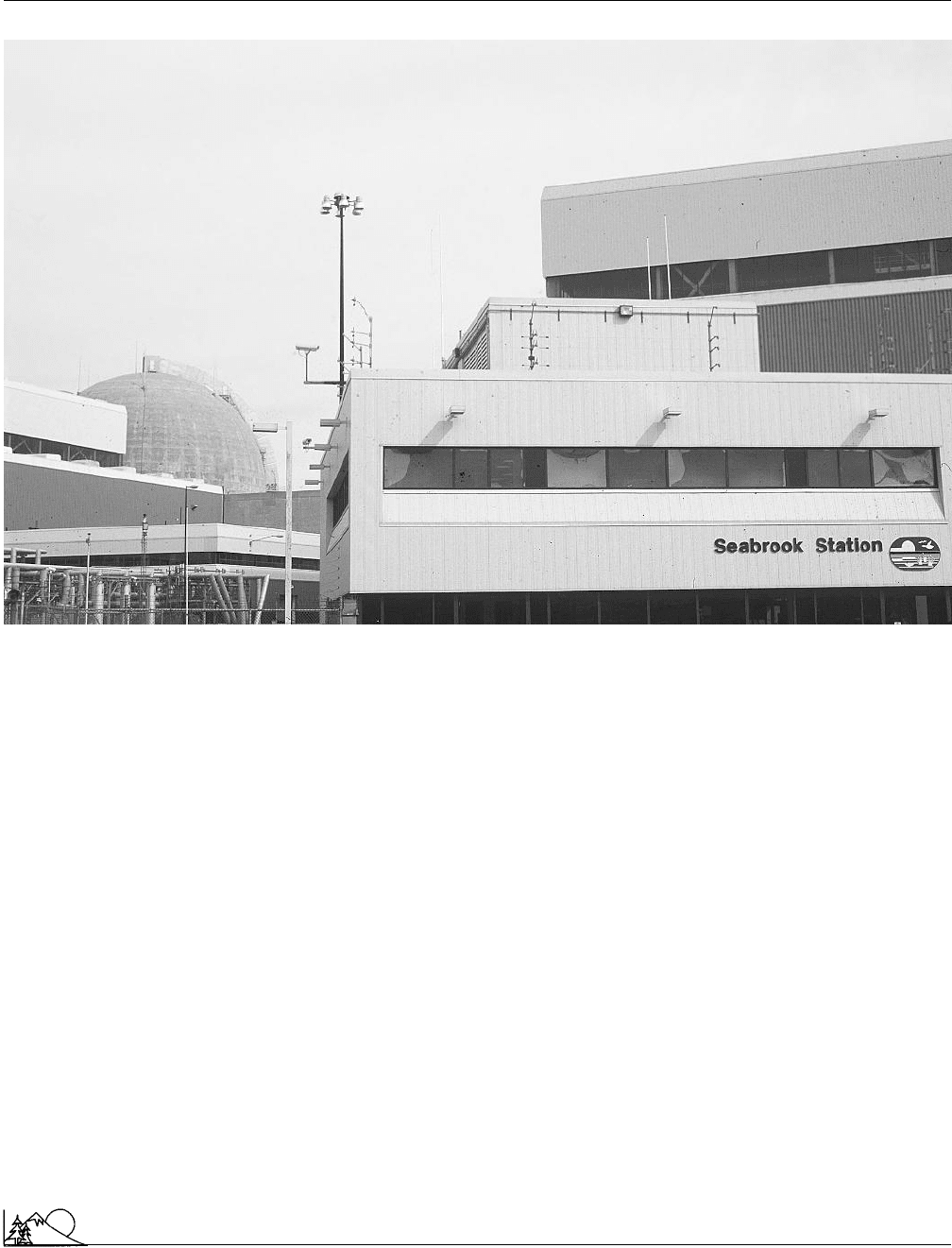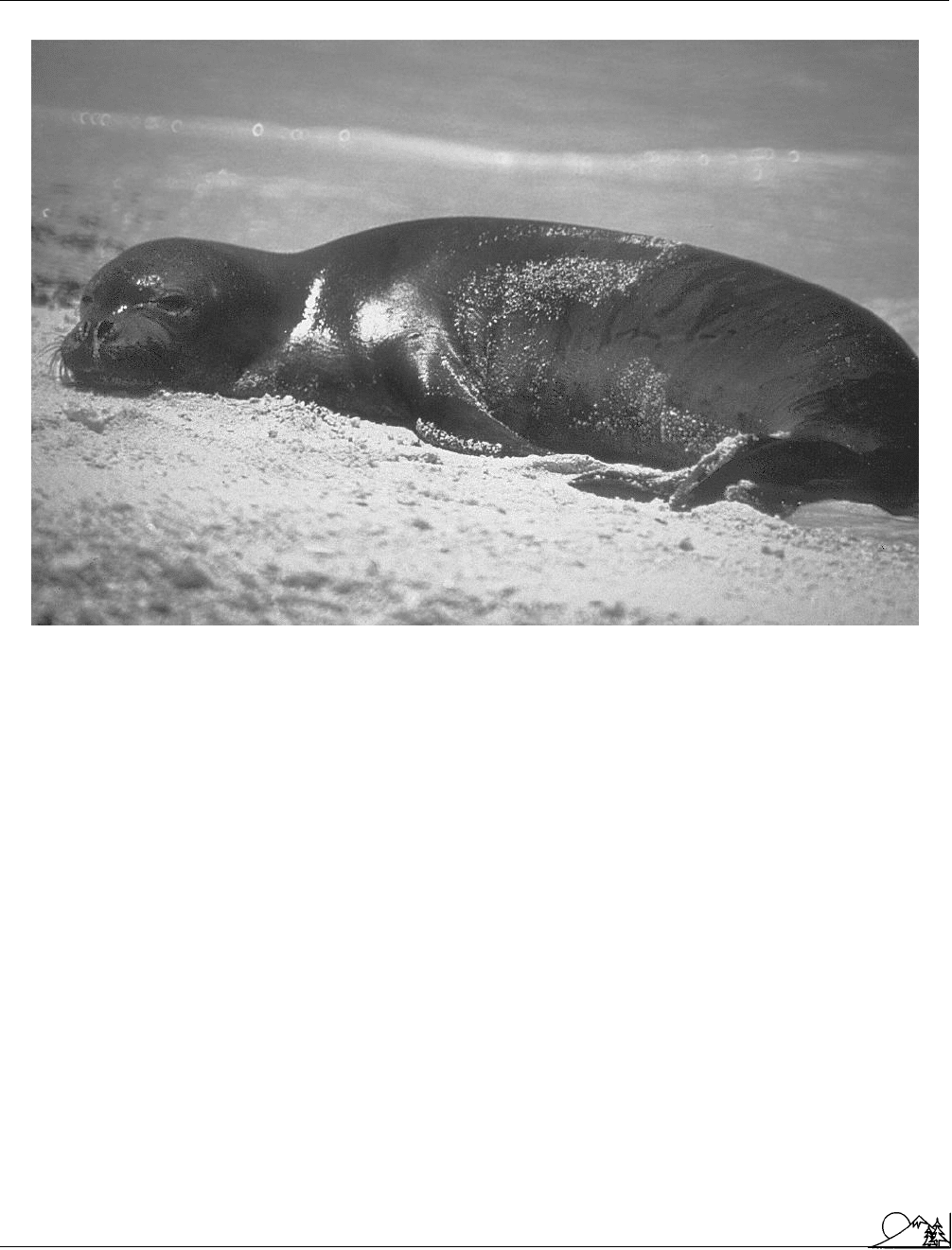Environmental Encyclopedia
Подождите немного. Документ загружается.


Environmental Encyclopedia 3
Seals and sea lions
Seabrook Nuclear Reactor (Seabrook, New Hampshire). (Photograph by Tom Pantages. Reproduced by permission.)
R
ESOURCES
P
ERIODICALS
Shulman, S. “Embattled Seabrook Wins License at Last.” Nature (March
8, 1990): 96.
Wasserman, H. “Clamshell Alliance: Getting It Together.” Progressive
(September 1977): 14–18.
———. “Clamshell Reaction: Protest against Nuclear Power Plant at Sea-
brook, N.H. by Clamshell Alliance.” Nation (June 18, 1977): 744—749.
———. “Nuclear War by the Sea.” Nation (September 11, 1976): 203–205.
Seals and sea lions
Members of the suborder Pinnipedia, seals and sea lions are
characterized by paddle-like flippers on a pair of limbs. Most
pinnipeds are found in boreal or polar regions and are the
most important predators in many high latitude areas, feed-
ing primarily on fish and squid. Seals and sea lions catch
their prey during extended dives of up to 25 minutes at
depths of 2,625 ft (800 m) or more. Pinniped biologists
are interested in the physiological changes these animals
undergo during their dives. Known as mammalian dive re-
1267
sponse, a combination of reduced heart rate and a lowered
core body temperature enables these warm-blooded animals
to complete such dives.
Seals and sea lions must return to beaches and ice floes
each year to give birth. Here they raise their pups in large
congregations known as colonies. In some
species
the larger,
more aggressive males will form polygamous mating groups,
or harems, and claim and defend territories in these limited
breeding areas. Males that do not get to mate form “bachelor
male” groups in areas less suitable for weaning pups. Males
of most species of pinnipeds do not mate before age four
but may acquire harems when they attain large size and
fighting experience. Some individual seals have been known
to live as long as 46 years.
Because of the commercial value of their pelts, many
species of seals and sea lions are threatened by
hunting
.
One of the largest pinnipeds, the Stellar sea lion (Eumetopias
jubatus) has been steadily decreasing in numbers and is now
listed as endangered by the IUCN. Within 15 years, the
new pup count at the Marmot Island Rookery (the largest
known sea lion rookery in the world) decreased from an

Environmental Encyclopedia 3
Seals and sea lions
A Hawaiian monk seal. (Photograph by Jim Leupold. U.S. Fish & Wildlife Service. Reproduced by permission.)
average of 6,700 to only 804. The northern or Pribilof fur
seal (Callorhinus ursinus), which had been heavily exploited
for its fur and in steady decline since the mid-1950s, is now
listed as vulnerable. In California, the Guadeloupe fur seal
(Arctocephalus townsendi) is also listed as vulnerable. The
Monk seal (Monachus monachus) in the Mediterranean is
listed as critically endangered.
These animals are in danger from natural and man-
induced pressures, and the consequences of their demise are
unknown. Other than hunting, perceived competition with
fishermen,
pollution
, and
habitat
destruction are threaten-
ing pinnipeds. Despite the sanctions afforded by the
Marine
Mammals Protection Act
(1972), fishers continue to kill
seals that are “interfering” with fishing operations. Recent
revisions to the act require some vessels to include observers
who can monitor compliance with the law. Some environ-
mentalists contend that it is the fisher who “interferes” with
the seals. The California Department of Fish and Game
estimates that 2,000 seals die each year from accidental en-
tanglement in fishing nets.
In the summer of 1988, 18,000 harbor seals washed
up on European shores. They were discovered to be suffering
1268
from an acute viral infection, possibly due to an immune-
system breakdown. Chemical pollutants, mainly polychlori-
nated biphenyl (PCB), have been implicated in reduced
immune function in marine mammals, and levels of PCBs
have been constantly increasing in many coastal waters. A
connection has also been made between mass seal die-offs
and increasing temperature. Four of the six recorded mass
mortalities have occurred in the past 12 years, a period that
includes some of the warmest weather in the twentieth cen-
tury. Other pollutants, such as
heavy metals
, may also
affect seal health or reproductive ability.
Oil spills
also poison
seal food sources and reduce the insulation ability of the
seals’ fur.
Finally, the reduction of habitat for feeding and repro-
duction has not been investigated thoroughly. Reputedly
caused by reductions in prey-fish stocks due to
overfishing
and by development of coastal shorelines, this reduction may
negatively affect pinniped populations.
[William G. Ambrose Jr. and Paul E. Renaud]

Environmental Encyclopedia 3
Noah Seattle
R
ESOURCES
B
OOKS
Sumick, J. L. An Introduction to the Biology of Marine Life. 5th ed. Dubuque,
IA: W. C. Brown, 1992.
P
ERIODICALS
Gentry, R. “Seals and Their Kin.” National Geographic 171 (1987): 474–501.
Hersh, S. “Saga of North Sea Seals (Phocine Distemper Virus).” Sea Fron-
tiers 36 (1990): 55.
Rosenberg, S. “Sea Lions of Monterrey.” Sea Frontiers 35 (1989): 97–103.
Stirrup, M. “A Sea Lion Mystery.” Sea Frontiers 36 (1990): 46–53.
Stolzenberg, W. “Seals Under Siege: A Heated Warning.” Science News
138 (1990): 84.
Paul Bigelow Sears (1891 – 1990)
American ecologist and conservationist
Born in Bucyrus, Ohio, Paul Sears obtained bachelor’s de-
grees in zoology and economics, then earned a Ph.D. in
botany from the University of Chicago. He spent most of
his career as professor or head of various botany departments.
In these positions, Sears researched changes in native
flora
as a result of human activities, conducted pioneering studies
of fossil pollen, and studied the relationship between vegeta-
tion and climatic change. A respected and influential ecolo-
gist, he served as president of the
Ecological Society of
America
(1948) and received the ESA’s “Eminent Ecologist
Award” in 1965. He spent the last ten years of his academic
career as chair of the graduate program in
conservation
at
Yale University and retired in 1960.
Sears was one of the few biological ecologists interested
in
human ecology
, writing cogently and consistently in a
field that he saw as a problem in synthesis. In his 1957
Condon Lecture at the University of Oregon, titled “The
Ecology of Man,” he mandated “serious attention to the
ecology of man” and demanded “its skillful application to
human affairs.”
He considered ecology a “subversive subject,” arguing
that if it were taken seriously, it would “endanger the as-
sumptions and practices accepted by modern societies, what-
ever their doctrinal commitments.” But Sears was a optimist
and believed that scientists would eventually agree because
the nature of their work mandated that they have “confidence
that the world hangs together.”
As a conservationist, Sears believed that one of the
basic lessons ecology teaches is that materials cycle and re-
cycle through natural systems. Thus, he became a strong
advocate of intensive
recycling
by human societies. He also
taught that a return to greater use of human muscle power
would be healthy for people because it would promote fitness
and
energy conservation
, as well as an impact on the
biosphere
.
1269
Sears was also one of the few prominent ecologists to
successfully write for popular audiences. At least one of his
popular books, Deserts on the March, first published in 1935,
has become a minor American classic, reprinted in a fourth
edition in 1980. The title provides an apt summary: in it,
Sears documents the mistakes American farmers made in
creating conditions that led to the disastrous
Dust Bowl
.
This book had a major influence on the
soil conservation
movement in the United States.
Throughout his life, Sears believed that the best way
to solve ecological problems was to teach every person about
their own immediate
environment
: “Each of us can begin
quite simply by learning to look about himself, wherever he
may be.” The touchstone of education, especially a scientific
one, should be “the final ability to read and enjoy the land-
scape. While there is life there is hope, but only for the
enlightened.”
[Gerald L. Young Ph.D.]
R
ESOURCES
B
OOKS
Sears, P. B. Deserts on the March. 4th ed. Norman: University of Oklahoma
Press, 1980.
———. “The Processes of Environmental Change by Man.” In Man’s Role
in Changing the Face of the Earth, edited by W. L. Thomas Jr. Chicago:
The University of Chicago Press, 1956.
———. Where There is Life: An Introduction to Ecology. New York: Dell,
1970.
Noah Seattle (1786 – 1866)
Duwamish chief
Noah Seattle (or See-athl) was a chief of the Duwamish or
Suquamish tribe, one of the Salish group of the Northwest
Coast of North America. Born in the Puget Sound area in
1786, Seattle lived there until his death on June 7, 1866.
He was baptized a Roman Catholic about 1830 and is buried
in the graveyard of the Port Madison Catholic Church.
Ironically, Native Americans were banned by law from living
in Seattle, Washington, the city named after him, one year
after the chief’s death.
By most accounts, Seattle was a great orator and a
skilled diplomat. Although he never fought in a war against
white people, he was a warrior with a reputation for daring
raids on neighboring tribes. Seattle owned eight Native
American slaves, but freed them after President Abraham
Lincoln’s Emancipation Proclamation. He was the first to
sign the Port Elliott Treaty negotiations of 1855, which
surrendered most Native American lands in the Puget Sound
area for white settlement. He gave two short speeches on
that occasion, which are preserved in the National Archives

Environmental Encyclopedia 3
Secchi disk
in Washington, D.C. Both speeches encouraged others to
sign the agreement and to cooperate with the United States
authorities.
Seattle has become famous in recent years as the author
of one of the most widely quoted pieces of environmental
literature in the world. Among some familiar passages are:
“How can you buy or sell the sky, the warmth of the land?
The earth is our mother. This we know, the earth does not
belong to man. Man belongs to the earth. Whatever befalls
the earth, befalls the sons of the earth. Man did not weave
the web of life; he is merely a strand in it. Whatever he does
to the web, he does to himself.”
Generally called the speech, letter, or lament of Chief
Seattle, this text exists in many forms. It has been set to
music, called the Fifth Gospel in religious services, and used
to sell everything from toilet tissue to recyclable plastic bags.
A version was used by artist Susan Jeffers in 1991 to accom-
pany drawings in a best selling children’s book called, Brother
Eagle, Sister Sky. This piece is a poetic, moving, environmen-
tally sensitive work that supports beliefs about the reverence
of Native Americans for the earth. Unfortunately, there is
no evidence that Chief Seattle ever said any of the wise
words attributed to him.
Historian Rudolf Kaiser has traced the origins and
myths surrounding the Chief Seattle text. The first report
of what we now know as Seattle’s speech appeared in an
article by Dr. Henry A. Smith published in the Seattle Sunday
Star on October 29, 1887, as part of a series of old pioneer
reminiscences. Smith was recalling remarks made by the
Chief in 1854 on the arrival of Governor Stevens to the
territory. Although 33 years had passed since the event,
Smith wrote that he clearly remembered the “grace and
earnestness of the sable old orator.”
As Smith reconstructed it, the speech was dark and
gloomy, the farewell of a vanishing race. “Your God loves
his people and hates mine...It matters but little where we
pass the remainder of our days. They are not many...Some
grim Nemesis of our race is on the redman’s trail, and wher-
ever he goes he will still hear the sure approaching footsteps
of the fell destroyer.” This version was mostly a justification
for displacement of the native peoples by the pioneers. Smith
remembered the Chief saying that the President’s offer to
buy Native American lands was generous “for we are no
longer in need of a great country.” This version has no
mention of the web of life or other ecological concepts.
In 1969 Smith’s stuffy Victorian prose was translated
into modern English by poet William Arrowsmith. Two
year later, Ted Perry wrote the script for a film called Home
produced by the Southern Baptist Convention. He used
some quotes from Arrowsmith’s translation together with a
great deal of imagery, symbolism, and sentiments of 1970s
environmentalism
. Perry is the source of 90% of what we
1270
now know as Seattle’s speech. Over Perry’s objections, the
film’s editors attributed the text to Chief Seattle to make it
seem more authentic.
The piece has since assumed a life of its own. Some
obvious inconsistencies exist, such as “hearing the lovely cry
of the whippoorwill” or having “seen a thousand rotting
buffaloes on the
prairie
, left by the white man who shot
them from a passing train.” Chief Seattle lived his whole
life in the Puget Sound area and died 13 years before the
railroads reached the West Coast. He never heard a whip-
poorwill or saw a buffalo. Many people who use the speech
are unperturbed by evidence that it is untrue. It so perfectly
supports their view of Native Americans that they believe
some Native American should have said these things even
if Seattle did not.
This story is a good example of a myth that persists
because it fits our preconceived views. In Chief Seattle, we
seem to find an unsophisticated primitive who spoke in
poetic, beautiful language and prophesied all the evils we
now experience. Indigenous cultures probably contain much
ecological wisdom that can be taught to others, but care
must be taken not to blindly accept mythological texts such
as this.
[William P. Cunningham Ph.D.]
R
ESOURCES
B
OOKS
Kaiser, R. “Chief Seattle’s Speech(es): American Origins and European
Reception—Almost a Detective Story.” In Indians in Europe, edited by C.
F. Feest. Gottingen, 1985.
Secchi disk
A simple instrument used to measure the transparency of
surface water bodies such as lakes and reservoirs. A Secchi
disk is a metal, plastic, or wooden disk that is 8–12 in (20–
30 cm) in diameter. It may be white or have alternating
black and white quadrants. A long calibrated rope is attached
to the center of the disk. Researchers use the disk by lowering
it into the water, usually from the shaded side of a boat,
and measuring the depth at which it just disappears from
sight. The disk is then lowered a little more and then raised
until it reappears. The average of the depths at which the
disk disappears and then reappears is known as the Secchi
depth. The amount of
sediment
, algae, and other solids in
the water affects clarity and depth of light penetration and
thus, Secchi depth. Scientists use this measure of transpar-
ency as a simple indication of
water quality
, often by com-
paring Secchi depth measurements over a period of time to
track changes in the clarity of a particular water body.

Environmental Encyclopedia 3
Secondary recovery technique
Testing water clarity with a secchi disk. (Photo-
graph by W.A. Banaszewski. Visuals Unlimited. Repro-
duced by permission.)
Second World
The former Soviet Union and those (formerly) communist
states that were politically and economically allied with it
are often informally called the Second World. The term
1271
developed after World War II to distinguish communist
bloc states from powerful capitalist states (
First World
) and
from smaller, nonaligned developing states (
Third World
).
These terms developed as a part of theories that the world’s
countries together made up a single dynamic system in which
these three sectors interacted. Although the term is often
used to indicate countries and regions of intermediate eco-
nomic strength, its proper meaning has to do with political
economy, or the politics of communist-socialist economics.
In recent years, with the shrinking role and then disintegra-
tion of the communist bloc, the term has become much less
common than those of First and Third Worlds.
Secondary recovery technique
The term secondary recovery technique refers to any method
for removing oil from a
reservoir
after all natural recovery
methods have been exhausted. The term has slightly different
meanings depending on the stage of recovery at which such
methods are used.
The oil trapped in an underground reservoir is typically
mixed with water,
natural gas
, and other gases. When a
well is sunk into the reservoir, oil may flow up the well pipe
to the earth’s surface at a rate determined by the concentra-
tion of these other substances. If the gas pressure is high,
for example, the oil may be pushed out in a fountain-like
gusher.
Flow out of the reservoir continues under the influence
of a number of natural factors, such as gravity, pressure of
surrounding water, and gas pressure. Later, flow is continued
by means of pumping. All such recovery approaches that
depend primarily on natural forces are know as primary
recovery techniques.
Primary recovery techniques normally remove no more
than about 30% of the oil in a reservoir.
Petroleum
engineers
have long realized that another fraction of the remaining oil
can be forced out by fluid injection. The process of fluid
injection involves the drilling of a second hole into the
reservoir at some distance from the first hole through which
oil is removed. Some gas or liquid is then pumped down
into the second hole, increasing pressure on the oil remaining
in the reservoir. The increased pressure forces more oil out
of the reservoir and into the recovery pipe.
The single most common secondary recovery tech-
nique is water
flooding
. When water is pumped into the
second well, it diffuses out into the oil reservoir and tends
to displace oil from the particles to which it is absorbed.
This process forces more of the residual oil up into the
recovery pipe.
Water flooding was used as early as 1900, but did not
become legal until 1921. A common practice was to drill a

Environmental Encyclopedia 3
Secondary recovery technique
series of
wells
, some of which were still producing and
others of which employed water injection. As the former
became exhausted, they were converted to water injection
wells and another group of producer wells were drilled. The
process was repeated until all available oil was recovered
from the field.
Recently, more sophisticated approaches to fluid injec-
tion have been developed from a reservoir. The two fluids
that have been used most extensively in these approaches are
liquid
hydrocarbons
and
carbon dioxide
. The principle
behind liquid hydrocarbons is to find some material that
will mix completely with oil and then push the oil-mixture
that is formed out of the reservoir into the recovery pipe. A
commonly used hydrocarbon for this process is liquified
petroleum gas (LPG), which is completely miscible with oil.
Since LPG is fairly expensive, only a small volume is
actually used. It is pumped down into the reservoir and
followed by a “pusher gas.” The pusher gas, often
methane
,
is inexpensive and can be used in larger volume. The pusher
gas forces LPG into the reservoir where it (the LPG) mixes
with residual oil.
This system has worked well in the laboratory, but
not so well in actual practice. The LPG has a tendency to
get lost in the reservoir to an extent that it does not effectively
remove very much residual oil.
The most effective fluid now available for injection
appears to be
carbon
dioxide. A mixture of carbon dioxide
and water is pumped down into the reservoir and followed
by an injection of pure water that drives the carbon dioxide-
water mixture through the reservoir. As carbon dioxide
comes into contact with oil, it dissolves in the oil, causing
it to expand and break loose from surrounding rock. The
oil-carbon dioxide-water is then pumped out of the recovery
pipe where the carbon dioxide is removed from the mixture
and re-used in the next recovery pass.
The carbon dioxide process has been effective in re-
moving oil after water flooding has already been used and
only 25% of the oil in a reservoir still remains. In most cases,
however, it is more efficiently used with reservoirs containing
a larger fraction of residual oil.
Fluid injection is one type of secondary recovery tech-
nique. Another whole group of methods can also be used
to extract the remaining oil from a reservoir. If these methods
are employed after fluid injection has been tried, they are
often referred to as tertiary recovery techniques. If they are
used immediately after primary recovery, they are known
as secondary recovery techniques. A whole set of recovery
techniques can be called by different names, therefore, de-
pending on the stage at which they are used. It is becoming
more common today to refer to any method for removing
the residual oil from a reservoir as an enhanced recovery
technique.
1272
Another technique for removing residual oil from a
reservoir makes use of surfactants. A surfactant is a substance
whose molecules are attracted to water at one end and oil
at the other end. The most familiar surfactants are probably
the soaps and
detergents
found in every home.
If surfactants are injected into an oil reservoir, they
will form emulsions between the oil and water in the reser-
voir. The oil is essentially washed off particles of rock in the
reservoir the way grease is washed off a pan by a household
detergent. The emulsion that is formed is then pushed
through the reservoir and out the producer pipe by a flood
of water pushed down the injection pipe.
The surfactant method works well in the laboratory,
although it has been less successful in the field. Surfactants
tend to adsorb on rock particles and get left behind as the
water pushes forward. Methods for overcoming this problem
are now being explored.
One of the fundamental problems with recovering
residual oil in a reservoir is that oil droplets often have
difficulty in squeezing through the small openings between
adjacent rock particles. The use of surfactants is one way of
helping the oil particles slip through those openings more
easily. Another approach is to increase the temperature of the
oil in the reservoir, thereby reducing its viscosity (tendency to
flow). As it becomes less viscous, the oil can more easily
force its way through pores in the reservoir.
One of the earliest applications of this principle, the
steam soak method, was first used in Venezuela in 1959. In
this method, steam is injected into one part of the reservoir
and the producer pipe is closed off. After a few days, the
pipe is reopened, and the loosened oil flows out. This process
is repeated a few times before a change is made in the method
and steam is piped in continuously while the producer pipe
remains open.
Steam injection works especially well with heavy oils
that are not easily displaced by other secondary recovery
techniques. It is now used commercially in a number of
fields, primarily in Venezuela and California.
A dramatic form of secondary recovery is in situ (in
place)
combustion
. The principle involved is fairly simple.
A portion of the oil in the reservoir is set on fire. The heat
from that fire then warms the remaining residual oil and
reduces its viscosity, forcing it up the producer pipe.
In practice, the fire can sometimes be made to ignite
spontaneously simply by pumping air down the
injection
well
. In some cases, however, the oil must actually be ignited
at the bottom of the well. The temperature produced in this
process may reach 650–1200°F (350–650°C) and the region
of burning oil may creep through the rock at a speed of 1–
12 in (3–30 cm) per day. As the fire continues, air, and
usually water, are continually pumped into the injection well
to keep the combustion zone moving. Under the best of

Environmental Encyclopedia 3
Seed bank
circumstances, in situ combustion has recovered up to half
of all the oil remaining in a reservoir.
Research has demonstrated that each recovery method
is suitable for particular kinds of reservoirs. Oil viscosity,
rock porosity, depth of the reservoir, and amount of oil
remaining in the reservoir are all factors in determining
which method to use. To date, however, the only method
that has proved to be practical in actual field situations is
steam injection.
[David E. Newton]
R
ESOURCES
B
OOKS
Dickey, P. A. Petroleum Development Geology. 3rd ed. Tulsa, OK: PennWell
Books, 1986.
Secondary standards
Pollution control
levels that affect the welfare of plants,
animals, buildings and materials. Secondary standards may
relate to either
water quality
or
air pollution
under the
control of either the
Safe Drinking Water Act
or the
Clean
Air Act
. These so-called “welfare effects” are thought not to
affect human health but primarily crops, livestock, vegeta-
tion, and buildings. Secondary standards can refer to effects
to which some monetary value could be ascribed, such as
damage to materials,
recreation
,
natural resources
, com-
munity property, or aesthetics.
Primary standards
, on the
other hand, refer to
pollution
levels that affect human
health.
Second-hand smoke
see
Cigarette smoke
Secure landfill
see
Landfill
Sediment
A mixture of sand,
silt
, clay, and perhaps organic compo-
nents.
Soil
eroded from one location and deposited in an-
other is identified as sediment. The sedimentary fraction
has the ability to carry not only the mineral (sand, silt,
and clay) and organic (
humus
) components, but also other
components that may be attached such as
nitrogen
com-
pounds, herbicides, and pesticides. These riders are of high
concern to those involved in environmental studies. Products
applied to the soil in one location and beneficial to that
1273
system may be transported to other locations where the effect
is detrimental to the
habitat
of other life forms. Care must
be exercised: 1) when applying supplementary items to the
soil, and 2) to develop systems that keep sediment from
finding its way into the streams and water bodies.
Sedimentation
The deposition of material suspended in a liquid. Sedimenta-
tion is normally considered a function of water deposition
of the finer
soil
separates of sand,
silt
, and clay, but it may
also include organic debris. Sometimes this is referred to as
the
siltation
process, although there may be other fractions
of material present other than silt. The term can be applied
to wind-transported sediments as well. Sedimentation can
be both harmful and beneficial. River and stream channels,
reservoirs, and other water bodies may be degraded because
of the deposition of
sediment
materials. Many of the most
important food- and fiber-producing soils of the world have
been developed from the deposition of fine particulates by
both water and wind. In some cases, large topographic land
forms are the result of long-term sedimentation processes.
Seed bank
A seed bank is the reservoir of viable seeds present in a
plant community. Seed banks are evaluated by a variety of
methods. For some
species
, it is possible to make careful,
direct counts of viable seeds. In most cases, however, the
surface substrate of the
ecosystem
must be collected and
seeds encouraged to germinate by exposure to light, mois-
ture, and warmth. The germinating seedlings are then
counted and, where possible, identified to species.
In most cases, the majority of seeds are found in surface
layers. For example, the organic-rich forest floor contains
almost all of the forest’s seed bank, with much smaller num-
bers of seeds present in the mineral
soil
.
The seeds of some plant species can be remarkably
long-lived, extending the life of the seed bank. For example,
in northeastern North America, the seeds of pin cherry
(Prunus pensylvanica) and red raspberry (Rubus idaeus) can
persist in the forest floor for perhaps a century or longer.
This considerably exceeds the period of time that these ru-
deral species are present as mature, vegetative plants during
the initial stages of post-disturbance forest
succession
.
However, because these species maintain a more-or-less per-
manent presence on the site through their persistent seed
bank, they are well placed to take advantage of temporary
opportunities of resource availability that follow disturbance
of the stand by
wildfire
, windstorm, or harvesting.

Environmental Encyclopedia 3
Seepage
The seeds of many other plant species have only an
ephemeral presence in the seed bank. In addition to some
tropical species whose seeds are short-lived, many species in
temperate and northern latitudes produce seeds that cannot
survive exposure to more than one winter. This is a common
trait in many grasses, asters, birches, and most conifers,
including pines, spruces, and fir. Often these species produce
seeds that disperse widely, and can dominate the short-lived
seed banks during the autumn and springtime. Species with
an ephemeral presence in the seed bank must produce large
numbers of well-dispersed seeds each year or at least fre-
quently, if they are to successfully colonize newly disturbed
sites and persist on the landscape.
Although part of the plant community, seed banks are
much less prominent than mature plants. In some situations,
however, individual plants in the seed bank can numerically
dominate the total-plant density of the community. For
example, in some cultivated situations the persistent seed
bank can commonly build up to tens of thousands of seeds
per square meter and sometimes densities which exceed
75,000 seeds per square meter. Even natural communities
can have seed banks in the low tens of thousands of seeds
per square meter. However, these are much larger than the
densities of mature plants in those ecosystems.
The seed bank of the plant community is of great
ecological importance because it can profoundly influence
the vigour and species composition of the vegetation that
develops after disturbance.
[Bill Freedman Ph.D.]
R
ESOURCES
B
OOKS
Harper, J. L. Population Biology of Plants. San Diego: Academic Press, 1977.
Grime, P. Plant Strategies and Vegetation Processes. New York: Wiley, 1979.
Seed dressings
see
Methylmercury seed dressings
Seepage
The process by which water gradually flows through the
soil
. Seepage is the cause of a variety of environmental
problems. For example, pesticides used on a farm may enter
groundwater
and be transported by seepage to a human
water supply. In some cases, toxic or radioactive wastes stored
in sealed tanks underground have gotten into water supplies
by seepage after the tanks have rusted and broken apart. See
also Water quality
1274
Selection cutting
A harvesting method that removes mature trees individually
or in small groups. The resulting gaps in the canopy allow
understory trees to develop under the protection of the re-
maining overstory. Among all regeneration methods selec-
tion cuttings offer seedlings the most protection against sun
and wind. They also protect against the
erosion
of
soil
and
maintain aesthetic value in forests. On the negative side,
selection
logging
can damage the remaining trees and re-
quires highly skilled labor and more expense. Because most
of the overstory remains, selection cutting favors shade-
tolerant
species
and is not appropriate when the goal is
growth of light-demanding species. See also Clear-cutting
Sellafield (U.K.)
see
Windscale (Sellafield) plutonium
reactor
Sense of place
Every adult seems to remember a special place from their
past: a place of refuge as a child; sites of family vacations;
a grandparent’s farm; somewhere shared with a loved one
at a special time. Many people, though often with some
embarrassment, will confess to a favorite place in the present
where they can go to be alone, to gather with friends, or
spend leisure time. Places we can identify with—and that
feel special. A literature about that identification with
place—that sense of place—has burgeoned in the last two
decades of the twentieth century.
Yet, contemporary literature, both fictional and fac-
tual, is packed with documentation of alienation, root-
lessness, displaced people, loss of connection to any particular
place, loss of identity and character in suburb and city. In
1957, in America as a Civilization, Max Lerner documented
the loss of community and the quest to regain it, claiming
“this is what I call the problem of place in America, and
unless it is somehow resolved, American life will become
more jangled and fragmented than it is, and American per-
sonality will continue to be unquiet and unfulfilled.” As the
century ends, an increasing number of scholars, thinkers,
and writers are advocating a reinhabitation of place, a
recla-
mation
of the spirit and sense of place as a solution to
numerous contemporary problems, including
environmen-
tal degradation
, sustainability, and social alienation.
Sense of place as a phrase has at least two meanings.
First, the particular characteristic of a place that makes it
what it is. For example, though few people have visited
Antarctica
, most have some sense, an image in their mind’s
eye, of what that continent is like. That image may be

Environmental Encyclopedia 3
Septic tank
realistic, or unrealistic, or may be dramatically simplified,
but it will usually be based on physical characteristics that
the place actually does have.
The second meaning is the particular sense that indi-
viduals have of places they know by experience; we all have
a sense of many places that we have visited, but a sense of
the same place is experienced in many ways by many different
people. Even after a visit to Antarctica, for example, people
will return with a variety of different views, depending on
their reasons for being there, on how long they stayed, and
on how much they know about the place. An explorer will
carry one view, a natural scientist studying how organisms
adapt to extreme environments will bring back a quite differ-
ent view, and a tourist yet another viewpoint. Yi-Fu Tuan
even claimed that “sense of place...implies a certain distance
between self and place that allows the self to appreciate a
place.”
For many, a third meaning is the only one of conse-
quence: that one can gain a sense of place only from being
or becoming deeply involved with a place and by coming to
know that one place and its inhabitants intimately. This is
the meaning implicit in the claim that modern Americans
must regain a sense of place to counteract their mobility and
alienation from
environment
. The poet Gary Snyder refers
to this when he claims that “there are many people on the
planet now who are not ‘inhabitants.’ He teaches that spirit
of place is accessed only through knowledge gained by direct
experience in a specific locale; “Know the plants” has become
almost his mantra. When you really know the plants, you
are beginning to get a sense of the place, a sense of what is
possible and a sense of how to live there in harmony with
the site and setting.
Interwoven with the concept of place is the sense of
home. We all have a sense of many places (in the first two
meanings of the phrase), but a feeling of home is always
associated with a sense of that specific place where home is
thought to be. Home can be a dwelling, a town, even a state
or a nation (in the sense of “homeland”)—or all of these—
but it always is a place, at one or several scales. Most of us
live in some degree of intimacy with the place we call home;
even if that is restricted to a dwelling, it is a place we
know and are to some degree comfortable with. Beyond the
dwelling, and even our identity with region and nation, to
recognize what it means to say “the earth is our home” might
change the way we behave toward the world on which we live.
Scholars and students agree that sense of place in
all three meanings is best developed by increasing one’s
knowledge of the locality in question. A full sense of the
third meaning can only be developed by really getting to
know one place well. That usually means living there, becom-
ing engaged with the surroundings, getting involved with
the community, making enough of a commitment of time
1275
to get beyond the surface. It takes real effort to get to know
the plants (even in cities, to know what the trees and shrubs
are in the parks and on the streets, and to know why those
particular
species
are there rather than others), to know, in
rural areas, what crops are planted and why, to know the
climatic patterns and the reasons for those patterns. If such
a sense of place could be enhanced and strengthened, this
might change the way people use energy in their homes
and cars, interact with other parts of the environment, and
consider how connected each of us really is to the particular
places where we live.
Some of the best American literature focuses on the
complex relationships of an individual writer with a specific
place. For example, Henry David Thoreau’s Walden Pond
trumpeted the personal significance and the transcendence
of one small place. More recently, Aldo Leopold’s struggle
to reclaim a ravaged farm in the sand counties of Wisconsin
has become a metaphor for attempts to understand the im-
portance to human lives of being immersed in the workings
of a place of one’s own. Annie Dillard’s mystical tome on
Tinker Creek has, as a modern day Walden, helped many
better understand the spirit of place. And, the “Refuge”
Terry Tempest Williams found on the shores of the Great
Salt Lake has generated empathy for the human condition
and for the natural world with which it is so entwined.
If, says the poet Wendell Berry, you don’t know where
you are, you don’t know who you are. People who have a
better sense of who they are by knowing more about the
places where they are, start paying attention to the impact
those places have on their lives. Recognizing that place and
identity are related, that place and well being cannot be
disconnected, should lead to taking better care of those
places.
[Gerald L. Young Ph.D.]
R
ESOURCES
B
OOKS
Swan, J., and R., eds. Dialogues With the Living Earth: New Ideas on the
Spirit of Place From Designers, Architects, and Innovators. Wheaton, IL:
Quest Books-Theosophical Publishing House, 1996.
Tall, D. From Where We Stand: Recovering a Sense of Place. Baltimore: The
Johns Hopkins University Press, 1993.
P
ERIODICALS
Cuba, L., and D. M. Hummon. “A Place to Call Home: Identification
With Dwelling: Community, and Region,” The Sociological Quarterly 34,
no. 1 (Spring 1993): 111–131.
Septic tank
Nearly 20 million homes, which include almost 30% of the
population of the United States, dispose of their
waste-

Environmental Encyclopedia 3
Septic tank
water
through an on-site disposal system. The most com-
monly used type of system is the septic tank, which is an
individual treatment system that uses the
soil
to treat small
wastewater flows. The system is usually used in rural or
large lot settings where centralized wastewater treatment is
impractical. Septic tank systems are designed specifically for
each site, using standardized design principles that are usu-
ally state-regulated. Septic tank systems commonly contain
three components: the septic tank, a distribution box, and
a drainfield, all of which are connected by conveyance lines.
The septic tank serves to separate solids from the
liquids in the wastewater. All sources of wastewater, includ-
ing those from sinks, baths, showers, washing machines,
dishwashers, and
toilets
, are directed into the septic tank,
since any of these waters can contain disease-causing
micro-
organisms
or environmental pollutants. The size of the
septic tank varies depending on the number of bedrooms in
the home, but an average tank holds 1,000 gal (3,790 l) of
liquid. Wastewater in a septic tank is treated by
anaerobic
bacteria that digest organic materials, while encouraging the
separation of solid materials from the wastewater. The solids
accumulate and remain in the septic tank in the form of
sludge
, which collects at the bottom of the tank, and also in
the form of scum, which floats on the top of the wastewater.
Periodically (for example, every two or three years) the indi-
gestible sludge and scum (referred to as septage) are removed
from the tank by pumping and are disposed of in a septage
disposal system (like a municipal
sewage treatment
sys-
tem). Unfortunately, many homeowners do not properly
maintain septic systems by pumping them out as frequently
as every two to three years and often wait until there is a
back up in the system or some other type of problem. Periodic
pumping is designed to prevent the solids from leaking out
of the septic tank in the wastewater
effluent
. The effluent
from the septic tank is a cloudy liquid that still contains
many pollutants (including
nitrogen
compounds, suspended
solids, and organic and inorganic materials) and microorgan-
isms (including bacteria and viruses, some of which that may
be potentially pathogenic), which require further treatment.
Treatment of the wastewater effluent from the septic
tank is continued by transporting the wastewater by gravity
to a soil
absorption
field through a connecting pipe. The
absorption field is also referred to as the soil drainfield or
the
nitrification
field. The absorption field consists of a
series of underground perforated pipes covered with soil and
turf, which may be connected in a closed loop system. The
wastewater enters a constructed gravel bed (the trench)
through perforations in the pipe, where it is stored before
entering the underlying unsaturated soil. The wastewater is
treated as it trickles into and through the soil by
filtration
and
adsorption
processes as well as by
aerobic
degradation
processes before the wastewater enters the ground water.
1276
Filtration removes most of the suspended solids and may
also remove microorganisms. Adsorption is the process by
which pollutants and microorganisms are attracted to and
held on the surfaces of soil particles, thus immobilizing them.
Adsorption attracts such nutrients such as
phosphorus
and
some forms of nitrogen (mostly ammonium [NH
4
]) and is
most effective when fine-textured soil is used as the adsorp-
tion medium. However, soils with a very fine texture, such
as soils high in clay, may have too low permeability to allow
much wastewater to pass through the soil. Microbial degra-
dation results in the removal of many remaining nutrients
and organic materials. If the volume and type of soil underly-
ing a soil absorption system are adequate, most pollutants
(with the exception of nitrate nitrogen) should be removed
before the wastewater reaches the
groundwater
.
Estuaries (bays, harbors, etc.) often experience nitro-
gen
loading
from septic systems along the shore (within
656 mi [200 m] of the shore or greater in sandy soil environ-
ments). Typically on-site disposal systems such as septic
tanks cannot remove more than 50–60% of the nitrogen
(mostly in the form of nitrate) and it ends up in the nearby
coastal waterway, which is a problem because many of the
estuaries around the world are experiencing problems with
eutrophication as a direct result of overloading of nitrogen.
Although some difficulties can arise with septic sys-
tems, there are some simple practices that can prevent com-
mon problems. For example,
groundwater pollution
and
surfacing of untreated or poorly filtered effluent from a septic
tank system can be prevented by ensuring that excessive
amounts of water are not allowed to enter or flood the
drainfield. Reduced production of wastewater, or
water
conservation
, is recommended to prevent system overload.
Water from roof drains, basement sump pump drains, and
other rain water or surface water
drainage
systems should
be directed away from the absorption field. The functioning
of the system can also be damaged by the addition of such
materials as coffee grounds, wet-strength towels,
dispos-
able diapers
, facial tissues, cigarette butts, and excessive
amounts of grease, which can clog the inlet to the septic
tank, or if carried out of the septic tank, may impede drainage
of wastewater in the soil absorption field. The septic tank
should be pumped more frequently if a
garbage
disposal
is used.
Groundwater
pollution
can also be caused by the addi-
tion of hazardous
chemicals
to the septic tank system, which
may be transported through the system to the ground water
without removal or treatment in the system. Hazardous
chemicals may be found in such commonly used products as
pesticides, solvents, latex paint, oven cleaners,
dry cleaning
fluids, motor oils, or degreasers.
Siting requirements for a soil absorption system de-
pend on the amount of daily sewage flow and site conditions
